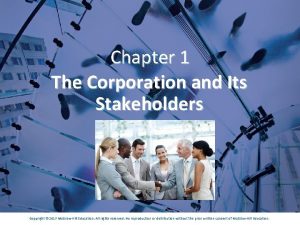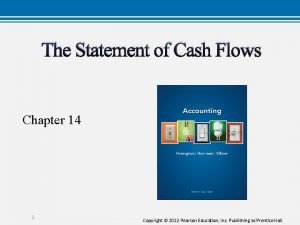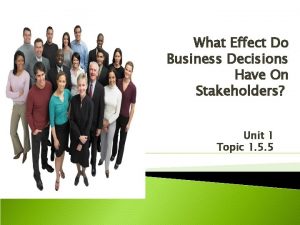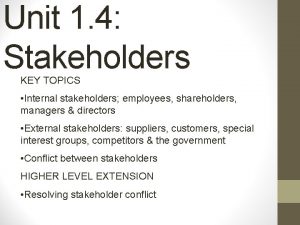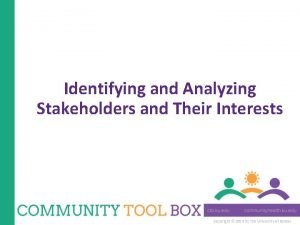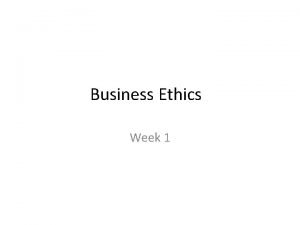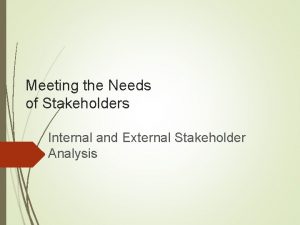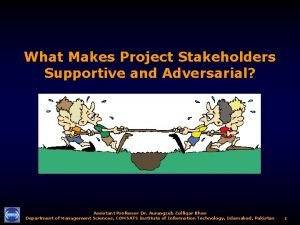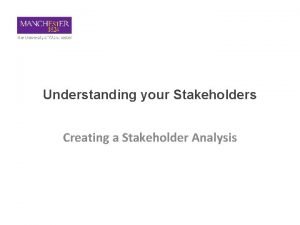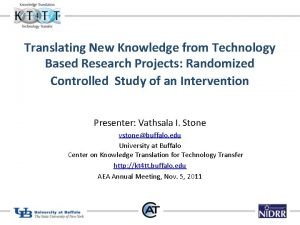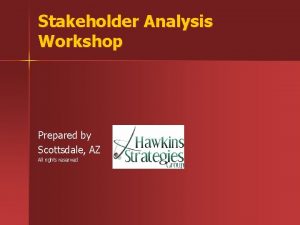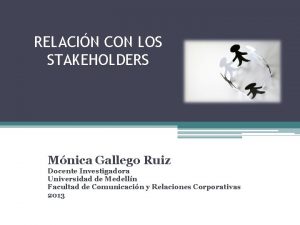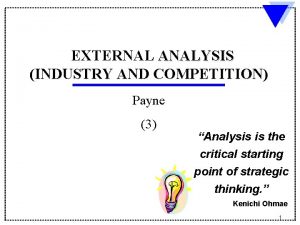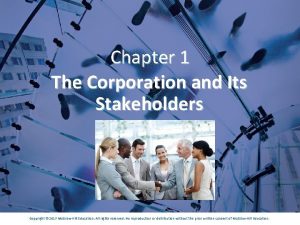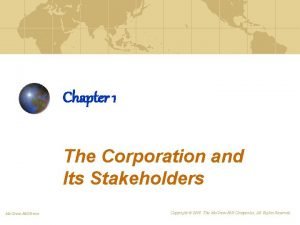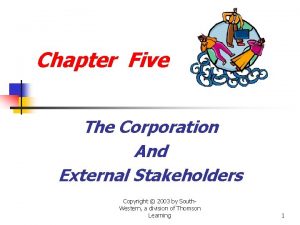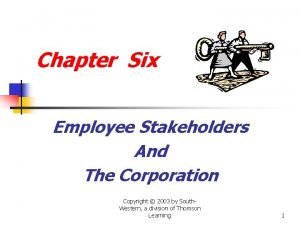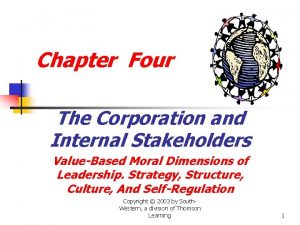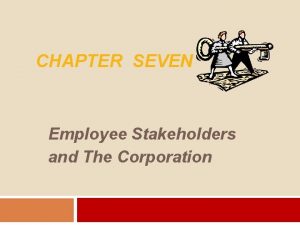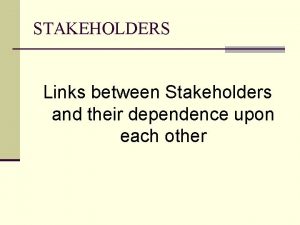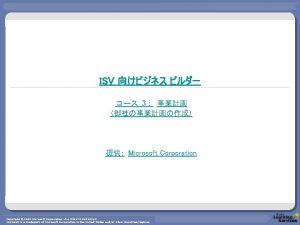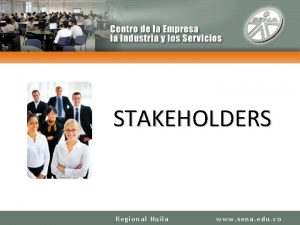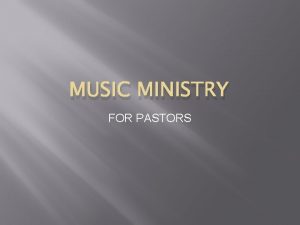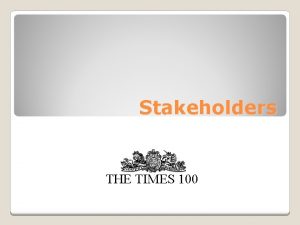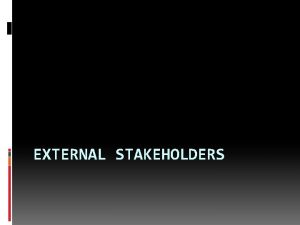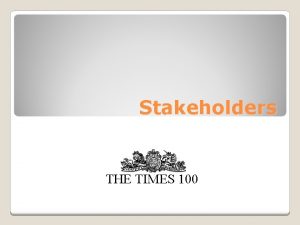Chapter 1 The Corporation and Its Stakeholders Copyright

























- Slides: 25

Chapter 1 The Corporation and Its Stakeholders Copyright © 2017 Mc. Graw-Hill Education. All rights reserved. No reproduction or distribution without the prior written consent of Mc. Graw-Hill Education.

Ch. 1: Key Learning Objectives § Understanding the relationship between business and society, and how they form an interactive system. § Considering the purpose of the modern corporation. § Knowing what a stakeholder is and who a corporation’s market and nonmarket and internal and external stakeholders are. § Conducting a stakeholder analysis and understanding the basis of stakeholder interests and power. § Recognizing the diverse ways in which modern corporations organize internally to interact with various stakeholders. § Analyzing the forces of change that continually reshape the business and society relationship. Copyright © 2017 Mc. Graw-Hill Education. All rights reserved. No reproduction or distribution without the prior written consent of Mc. Graw-Hill Education. 1 -2

Business and society together form an interactive social system § Business: organizations engaged in making a product or providing a service for profit. § Society: Human beings and the social structures they collectively create. Copyright © 2017 Mc. Graw-Hill Education. All rights reserved. No reproduction or distribution without the prior written consent of Mc. Graw-Hill Education. 1 -3

Business and society together form an interactive social system Figure 1. 1 Business and Society: An Interactive System Copyright © 2017 Mc. Graw-Hill Education. All rights reserved. No reproduction or distribution without the prior written consent of Mc. Graw-Hill Education. 1 -4

Business and society together form an interactive social system General Systems Theory (GST): § Organisms do not exist in isolation but can only be understood in relationship to their surroundings. § Businesses are embedded in a broader social environment with which they constantly interact. Copyright © 2017 Mc. Graw-Hill Education. All rights reserved. No reproduction or distribution without the prior written consent of Mc. Graw-Hill Education. 1 -5

Purpose of Business § What is the purpose of the corporation? § To whom, or what, should be firm be responsible? Copyright © 2017 Mc. Graw-Hill Education. All rights reserved. No reproduction or distribution without the prior written consent of Mc. Graw-Hill Education. 1 -6

Ownership Theory of the Firm § Sees the firm as property of owners (shareholders). § Owners’ interests take precedence over interests of others. § The purpose of the firm is to maximize its long-term market value and money for its shareholders. Copyright © 2017 Mc. Graw-Hill Education. All rights reserved. No reproduction or distribution without the prior written consent of Mc. Graw-Hill Education. 1 -7

Stakeholder Theory of the Firm § Corporations serve a broad public purpose: to create value for society. § Profit is necessary for survival but other values drive the firm’s purpose. § Corporations have multiple obligations and need to consider all stakeholders. Copyright © 2017 Mc. Graw-Hill Education. All rights reserved. No reproduction or distribution without the prior written consent of Mc. Graw-Hill Education. 1 -8

Ownership theory and stakeholder theory define the purpose of business differently Ownership Purpose üOwner’s Needs and Wants üShare Value Stakeholder Purpose üStakeholders’ Needs and Wants Copyright © 2017 Mc. Graw-Hill Education. All rights reserved. No reproduction or distribution without the prior written consent of Mc. Graw-Hill Education.

Three arguments in support of the stakeholder theory of the firm Descriptive Normative Instrumental Copyright © 2017 Mc. Graw-Hill Education. All rights reserved. No reproduction or distribution without the prior written consent of Mc. Graw-Hill Education. 1 -10

Stakeholders § Stakeholders are persons or groups that affect, or are affected by, a firm’s decisions, policies, and operations. § A stake is an interest in–or claim on–a business. § Stakeholder is NOT the same as stockholder (or shareholders). § Stockholders represent one of several kinds of stakeholders. Copyright © 2017 Mc. Graw-Hill Education. All rights reserved. No reproduction or distribution without the prior written consent of Mc. Graw-Hill Education. 1 -11

Two Kinds of Stakeholders: Market and Nonmarket § Market stakeholders Shareholders, suppliers, employees, etc. They engage in economic transactions with the company as it carries out its primary purpose of providing society with goods and services. Shareholders § Nonmarket stakeholders Community, government, business support groups, etc. People or groups who—although they do not engage in direct economic exchange with the firm—are affected by or can affect its actions. Community Government Competitors Environment Copyright © 2017 Mc. Graw-Hill Education. All rights reserved. No reproduction or distribution without the prior written consent of Mc. Graw-Hill Education. 1 -12

Example § In 2001, a company called Energy Management Inc. (EMI) announced a plan to build a wind farm about six miles off the shore of Cape Cod, Massachusetts, to supply clean, renewable power to New England customers. The project, called Cape Wind, immediately generated intense opposition from residents of Cape Cod and nearby islands, who were concerned that its 130 wind turbines would spoil the view and get in the way of boats. A nonprofit group called Save Our Sound filed dozens of lawsuits, charging possible harm to wildlife, increased electricity rates, and danger to aircraft. § In early 2015, EMI appeared blocked on all sides, as local utilities withdrew their commitments to buy power from the wind farm, which one local newspaper called the final “death blow. ” Copyright © 2017 Mc. Graw-Hill Education. All rights reserved. No reproduction or distribution without the prior written consent of Mc. Graw-Hill Education.

Internal stakeholders are employed by the firm external stakeholders are not Suppliers Employees Society Company Managers Government Creditors Shareholders Customers Internal stakeholders work “inside” the firm and contribute their effort and skill to everyday operations. External stakeholders may have important transactions with the firm, but are not on its payroll. Copyright © 2017 Mc. Graw-Hill Education. All rights reserved. No reproduction or distribution without the prior written consent of Mc. Graw-Hill Education. 1 -14

A Firm and Stakeholders Figure 1. 2 Copyright © 2017 Mc. Graw-Hill Education. All rights reserved. No reproduction or distribution without the prior written consent of Mc. Graw-Hill Education. 1 -15

Stakeholder analysis includes identification of relevant stakeholders and analysis of their interests and power Figure 1. 3 Copyright © 2017 Mc. Graw-Hill Education. All rights reserved. No reproduction or distribution without the prior written consent of Mc. Graw-Hill Education. 1 -16

Stakeholder Analysis Question 1 Who are the relevant stakeholders? § Draw market and nonmarket stakeholder maps. § Recognize not all groups are relevant to every situation. Examples: § Some businesses sell directly to the public and will not have retailers. § A certain stakeholder may not be relevant to a particular decision/action. Copyright © 2017 Mc. Graw-Hill Education. All rights reserved. No reproduction or distribution without the prior written consent of Mc. Graw-Hill Education. 1 -17

Stakeholder Analysis Question 2 What are interests of each stakeholder? § What are the groups’ concerns? § What does the group want/expect from their relationship with the firm? Examples: § Shareholders have an ownership interest; they expect to receive dividends and capital appreciation. § Customers are interested in gaining fair value and quality in goods and services they purchase. § Public interest groups advance broad social interests. Copyright © 2017 Mc. Graw-Hill Education. All rights reserved. No reproduction or distribution without the prior written consent of Mc. Graw-Hill Education. 1 -18

Stakeholder Analysis Question 3 What is the power of each stakeholder? § Stakeholder power is the ability of a group to use resources to make an event happen or to secure a desired outcome. § There are 5 types of stakeholder power: § § § Voting power Economic power Political power Legal power Informational power Copyright © 2017 Mc. Graw-Hill Education. All rights reserved. No reproduction or distribution without the prior written consent of Mc. Graw-Hill Education. 1 -19

Power examples § Activists often try to use all of these kinds of power when they want to change a company’s policy. For example, human rights activists wanted to bring pressure on Unocal Corporation to change its practices in Burma (Myanmar), where it had entered into a joint venture with the government to build a gas pipeline. Critics charged that many human rights violations occurred during this project, including forced labor and relocations. In an effort to pressure Unocal to change its behavior, activists organized protests at stockholder meetings (voting power), called for boycotts of Unocal products (economic power), promoted local ordinances prohibiting cities from buying from Unocal (political power), brought a lawsuit for damages on behalf of Burmese villagers (legal power), and gathered information about government abuses by interviewing Burmese refugees and publicizing the results online (informational power). These activists increased their chances of success by mobilizing many kinds of power. This combination of tactics eventually forced Unocal to pay compensation to people whose rights had been violated and to fund education and health care projects in the pipeline region. Copyright © 2017 Mc. Graw-Hill Education. All rights reserved. No reproduction or distribution without the prior written consent of Mc. Graw-Hill Education.

Stakeholder Analysis Question 4 How are stakeholder coalitions likely to form? § Stakeholder groups often have common interests and will form temporary alliances to pursue these common interests. § Coalitions are very dynamic (can change at any time). § Coalitions are increasing international. § Internet has enabled coalitions to form quickly, across political boundaries. Copyright © 2017 Mc. Graw-Hill Education. All rights reserved. No reproduction or distribution without the prior written consent of Mc. Graw-Hill Education. 1 -21

Stakeholder Salience and Mapping § Salient – stands out from a background, is seen as important, or draws attention. § Stakeholders stand out (i. e. , are salient) to managers when they have power, legitimacy, and urgency. § Managers can use the salience concept to develop a stakeholder map – a graphical representation of the relationship of stakeholder salience to a particular issue. § A stakeholder map is a useful tool, because it enables managers to see quickly how stakeholders feel about an issue. Copyright © 2017 Mc. Graw-Hill Education. All rights reserved. No reproduction or distribution without the prior written consent of Mc. Graw-Hill Education. 1 -22

Stakeholder Map Figure 1. 4 Copyright © 2017 Mc. Graw-Hill Education. All rights reserved. No reproduction or distribution without the prior written consent of Mc. Graw-Hill Education. 1 -23

The External Environment of Business is Dynamic and Ever Changing § The purpose of the firm is not simply to make a profit, but to create value for all its stakeholders – a successful business must meet both its economic and social objectives. § Six dynamic forces powerfully shape the business and society relationship: Changing societal expectations Growing emphasis on ethical reasoning and actions Globalization Evolving government regulations and business response § Dynamic natural environment § Explosion of new technology and innovation § § Copyright © 2017 Mc. Graw-Hill Education. All rights reserved. No reproduction or distribution without the prior written consent of Mc. Graw-Hill Education. 1 -24

Forces That Shape The Business And Society Relationship Figure 1. 6 Copyright © 2017 Mc. Graw-Hill Education. All rights reserved. No reproduction or distribution without the prior written consent of Mc. Graw-Hill Education. 1 -25
 Interactive social system
Interactive social system Destiny corporation is preparing its
Destiny corporation is preparing its Impact of business decisions on stakeholders
Impact of business decisions on stakeholders Key internal and external stakeholders
Key internal and external stakeholders How to write background of the project
How to write background of the project Stakeholders and their interests
Stakeholders and their interests Primary and secondary stakeholders
Primary and secondary stakeholders Stakeholder internal and external
Stakeholder internal and external Stakeholders in water and sanitation
Stakeholders in water and sanitation The emigree
The emigree Its halloween its halloween the moon is full and bright
Its halloween its halloween the moon is full and bright Adversarial stakeholders
Adversarial stakeholders Understanding your stakeholders
Understanding your stakeholders C level stakeholders
C level stakeholders Real estate stakeholders
Real estate stakeholders Stakeholder classification
Stakeholder classification Internal vs external stakeholders
Internal vs external stakeholders Internal stakeholers
Internal stakeholers Who are stakeholders of a company
Who are stakeholders of a company Bank stakeholders analysis
Bank stakeholders analysis Stakeholders scuola
Stakeholders scuola Stakeholders
Stakeholders Stakeholders scuola
Stakeholders scuola Internal stakeholders examples
Internal stakeholders examples Primary secondary stakeholders
Primary secondary stakeholders Multifiduciary approach
Multifiduciary approach
